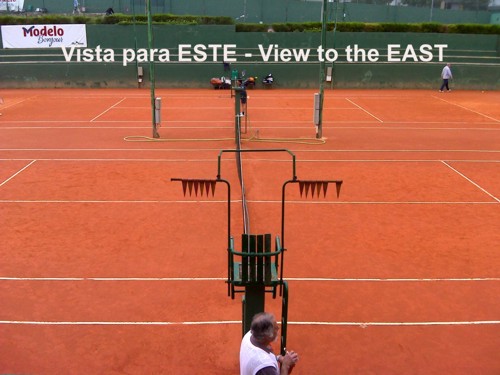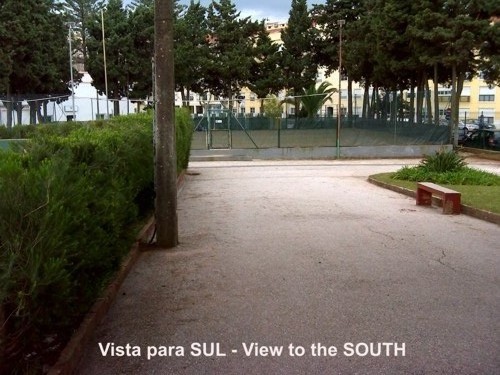
O ténis é jogado em uma superfície plana
retangular, geralmente de relva, saibro, ou em piso duro. O campo
tem 23,77m de comprimento, e sua largura é de 8,23m para
partidas de singulares, e 10,97m para partidas de pares. O
espaço adicional em torno do campo é requerido para
que jogadores possam alcançar a bola quando esta depassa os
limites da quadra. Uma rede é esticada a meio do campo em
toda a sua largura, paralela com as linhas de base, dividindo-a em
duas partes iguais. A rede tem 1,07m de altura nas extremidades, e
914mm de altura no centro.
 Há três tipos principais de campos,
dependendo dos materiais usados para a superfície da mesma.
Cada superfície fornece uma diferença na velocidade e
no salto da bola de ténis.
Há três tipos principais de campos,
dependendo dos materiais usados para a superfície da mesma.
Cada superfície fornece uma diferença na velocidade e
no salto da bola de ténis.
- Campo de argila/terra batida (saibro) - é composto por
terra e argila, coberta com pó de tijolo, um piso que torna
o jogo um pouco mais lento. As bolas saltam relativamente altas e
mais lentamente, fazendo com que seja mais difícil que um
jogador bata um tiro indefensável. Em campos de argila, as
linhas de chamada são facilmente visíveis porque a
bola deixa uma marca no solo. O Torneio de Roland Garros disputa-se
em quadras deste tipo.
- Campo de relva. É o piso mais rápido do
ténis, caracterizando-se pela irregularidade do ressalto da
bola (dependendo de quão saudável a relva é e
de quão recentemente foi cortada).
- Hardcourt (piso duro: cimento, borracha
sintética, carpete ou lama asfáltica). Este tipo de
campo abrange muitas superfícies diferentes, variando do
cimento, tartan ou asfalto até superfícies de madeira
ou relva artificial semelhante a AstroTurf. É um piso de
jogo rápido devido ao seu piso regular. Os ressaltos baixos
fazem com que as jogadas sejam curtas e poderosas; jogadores do
tipo serviço-rede têm vantagem neste tipo de
superfície.Nesse piso não exige muita
técnica.

Tennis is played on a rectangular flat
surface, usually of grass, clay, concrete (hard court) or a
synthetic suspended court. The court is 23.78 m long. Its width is
8.23 m for singles matches and 10.97 m for doubles matches. The
service line is 6.40 m from the net. Additional clear space around
the court is needed in order for players to reach overrun balls for
a total of 18.3 m wide and 36.7 m long. A net is stretched across
the full width of the court, parallel with the baselines, dividing
it into two equal ends. The net is 1.07 m high at the posts, and
0.914 m high in the center.
Clay
courts - Clay courts are made of crushed shale,
stone or brick. The red clay is slower than the green, Har-Tru,
"North-American" clay. The French Open uses clay courts, unlike the
other three Grand Slam tournaments of each year. Clay courts slow
down the ball and produce a high bounce when compared to grass
courts or hard courts. This is because clay courts have more grab
and when the ball lands there is more friction pushing against the
ball's horizontal path, therefore slowing it and creating a higher
bounce. For this reason, the clay court takes away some advantage
of big serves, which makes it hard for serve-based players to
dominate on the surface. Although clay courts are more traditional
and cheaper to construct than other types of tennis courts, the
maintenance costs of a clay surface are higher than those of hard
courts. Clay courts need to be rolled to preserve flatness. The
clay's water content must be balanced; green courts generally
require the courts to be sloped to allow water run-off. Clay courts
are more common in Europe and Latin America than in North America
and tend to heavily favor baseline players.
Grass courts -
Grass courts are the fastest type of courts in common use (AstroTurf is faster but is primarily only used for
personal courts). They consist of grass grown on very hard-packed
soil, which adds an additional variable: bounces depend on how
healthy the grass is, how recently it has been mown, and the wear
and tear of recent play. Points are usually very quick where fast,
low bounces keep rallies short, and the serve plays a more
important role than on other surfaces. Grass courts tend to favor
serve-and-volley tennis players, such as John McEnroe and Pete
Sampras among men and Martina Navratilova among women. The
International Tennis Hall of Fame in Newport, R.I., comprises grass
courts. The surface is less firm and more slippery than hard
courts, causing the ball to slide and bounce lower, and so players
must reach the ball faster. Serve-and-volley players take advantage
of the surface by serving the ball (usually a slice serve because
of its effectiveness on grass) and then running to the net to cut
off the return of serve, leaving their opponent with little time to
reach the low-bouncing, fast-moving ball. Players often hit flatter
shots to increase power and allow the ball to travel faster after
and before the ball hits the ground.
Grass courts were once among the most common
tennis surfaces, but are now rare due to high maintenance costs, as
they must be watered and mown often, and take a longer time to dry
after rain than hard courts. For a more extensive discussion of the
skills most advantageous on grass court, see grass-court
specialist.
Hard
courts - Hard courts (usually made of asphalt) are
very fast types of tennis courts, where fast hard-hitting players
have a slight advantage. Hard courts can vary in speed; they are
faster than clay but not as fast as grass courts. Depending on the
amount of sand added to the paint the amount the ball slows down
can vary greatly. These courts are considered the most equal for
all playing styles. The U.S. Open is played on an acrylic hard
court, while the Australian Open is played on a synthetic hard
court. The main difference between a synthetic hard court and a
true hard court surface is the level of hardness. When the ball
bounces on this surface it is faster than all other surfaces if
there is not much sand in the top paint. The amount of sand used in
the top paint and the size of the sand also determines the speed
– more sand means less speed and larger sand particles will
slow the speed of play. The amount of friction can also be altered
and more friction will produce a clay court effect, where topspin
is magnified. The extra grip and friction will resist the sliding
effect of the ball and the resistance will force the ball to change
its rotation. The extra grip provided by the surface can resist the
movement of the player and can cause injury.
Carpet
courts -Carpet is a tennis term for any removable
court covering. A short form of articial turf weighted with sand is
common in Asia. Indoor arenas store rolls of rubber-backed court
surfacing and install it temporarily for tennis events.
Indoor
courts -The same surface will play faster indoors
than outdoors. Hard courts are most common indoors. Slower, higher
bouncing rubberized surfaces are used for a cushioned feel. Clay
courts are installed indoors with underground watering systems.
Barnstorming professionals played on canvas laid over wooden
basketball courts up to the 1960's.
A cache / The cache
Esta cache é uma cache mistério.
Não está nas coordenadas indicadas na página
mas as suas coordenadas finais podem ser decifradas pela
informação fornecida na página. Para
encontrarem esta cache vão ter de olhar para as seguintes
imagens e decifrar, pela vista que apresentam, o ponto da cache. As
fotos foram tiradas do local onde a mesma está
escondida.
This is a mystery cache and is not located at the
published coordinates. However, the cache page has all the clues
necessary to decifer the final coordinates. To find this
cache you will have to decipher the cache's hiding place from the
three images supplied that were taken from GZ.
ESTE/EAST:

NORTE/NORTH:

SUL/SOUTH

Cuidados:
Não procurem a cache a altas horas da noite. Há
segurança!
Cuidado com os muggles!
Warnings:
Don't search for this cache late at night. There is roving
security.
atch out for muggles - Three strikes and you're OUT!
